INFO 21-1997: ISO celebrates its prolonged life with a video of Jupiter
22 July 1997
The Infrared Space Observatory ISO ought to be running out of fuel by now, 20 months after its launch on 17 November 1995, yet the astronomers and controllers at Villafranca in Spain are busier than ever. Thanks to meticulous engineering and some good fortune, the satellite's working life has stretched from a specified minimum of 18 months to more than 28 months. ESA's unique space telescope for exploring the cool and cloudy Universe by infrared rays should, according to present calculations, remain operational until April 1998.This is excellent news for astronomers and especially for the multinational teams, with leaders in France, Germany, the Netherlands and the United Kingdom, who spent many years devising the four instruments served by ISO's telescope. The camera ISOCAM, the photometer ISOPHOT, the Short Wavelength Spectrometer and the Long Wavelength Spectrometer span between them an unprecedented range of infrared wavelengths from 2 to 200 microns.
The atmosphere of Jupiter is one of the cool and cloudy places attracting ISO's attention, and ESA today releases a video of unprecedented images of Jupiter. The planet changes its appearance drastically as the camera ISOCAM scans a range of 90 different infrared wavelengths. Picture by picture, ISOCAM picks out different features of the atmosphere's composition and behaviour. These and other results from ISO will enable scientists to sharpen their ideas about how Jupiter's weather works.
"ISO is giving us a new impression of the giant planets of the Solar System," comments Roger Bonnet, ESA's director of science. "Not just Jupiter, but Saturn, Uranus and Neptune too. By observing the planets across its very wide range of infrared wavelengths, ISO can see features overlooked even by spacecraft visiting the planets. The remarkable movie of Jupiter released today represents only a few per cent of ISO's wavelength range, yet every image tells its own story."
How ISO's Cold Telescope Beat the Calendar
The need to keep ISO's telescope and instruments chilled to a very low temperature sets a limit to their useful operating life. ISO was supplied with more than 2000 litres of superfluid helium to cool it. Slow evaporation maintains key parts of the spacecraft at temperatures close to absolute zero, below minus 271 degrees C.
The rate of loss of helium was expected to be about 3 litres a day, but the cryogenic system could not be tested in exactly the conditions found in space. Prudence required an allowance for a possibly faster rate of evaporation, to ensure the specified 18 months of life. Three of the additional 10 months that have materialized represent that safety margin. The rest of the gain in ISO's operating life was fortuitous, partly because of favourable circumstances during the launch campaign at Kourou in French Guiana.
ISO was launched in its cold condition, and was expected to lose helium while waiting on the launch pad. During a technical check of the Ariane 44P launcher, ISO's engineers seized the chance to recharge the helium.
The launch then occurred at the very first opportunity, with 99 per cent of ISO's helium aboard instead of an expected 95 per cent - a gain of about a month's supply. Another month's advantage came about because the quick launch meant that the outer parts of the insulation system of the spacecraft had little time to warm up in Kourou's tropical climate.
High Hopes for Orion
Some of the prime targets of infrared astronomy lie in the direction of the Orion constellation, but without the extension of its life ISO could not have looked safely in that direction in the sky. The cold telescope must always remain averted from the intense infrared glow of both the Earth and the Sun. The orbit is constrained by the need to remain in touch with one or other of the ground stations, in Spain or California.
As a result ISO's first chance to examine in the Orion sector comes next month (August 1997). When astronomers learned, soon after launch, that the coolant supply would last long enough for Orion to come into ISO's view, they immediately clamoured for observations. But operational constraints will cause interruptions in September and early October. The same geometry that makes Orion safe for ISO's telescope also puts the satellite into the Earth's shadow for abnormally long periods on each orbit, cutting off the power from the spacecraft's solar panels.
Mission controllers are devising strategies to safeguard ISO during this tricky period, while giving the astronomical teams as much observing time as possible. Nevertheless, without the further extension of the spacecraft's life into 1998, the glimpses in the Orion sector might have been more tantalizing than satisfying for the astronomers. By February 1998, ISO will again be able to scan Orion, this time without any difficulties from the Earth's shadow. Then sustained observations will build on lessons learned from the results of 1997. Hopes are high for spectacular discoveries in ISO's swansong, just before its helium supply finally runs out.
"Astronomers stand to gain hugely from ISO's extended life," says Martin Kessler, the project scientist. "We have learned by now how to get the best results from our completely novel space observatory, so we can promise to use the extra observing time very effectively. What we can look at is important too. The biggest star factories in our vicinity sprawl across the Orion and Taurus constellations. The famous Orion Nebula is only their brightest spot. In August - September 1997 and February-March 1998, ISO will spend part of its extra life hunting for newly forming stars hidden in the Orion and Taurus clouds. It's a big bonus, and the results may well turn out to rank among ISO's finest achievements."
Jupiter's Atmosphere and ISO's video
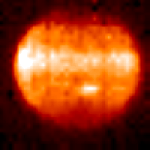 |
|
3.0 Microns |
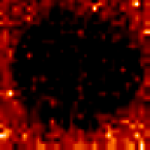 |
|
3.3 Microns |
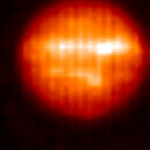 |
|
5.7 Microns |
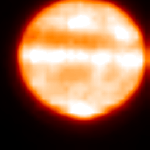 |
|
7.6 Microns |
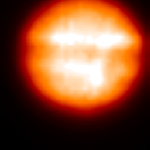 |
|
9.4 Microns |
|
All Images Credit: ESA/ISO, ISOCAM & Th. Encrenaz et al. |
If you had infrared eyes, you would see the Earth's own clouds radiating in different colours, or wavelengths, according to their temperatures. You could also recognize various gases in the air by colours due to their absorptions of particular wavelengths. Infrared instruments in meteorological and environmental satellites monitor the Earth's atmosphere routinely.
Jupiter's atmosphere yields its secrets in the infrared waveband to ISO, which sees the whole sunward side of the planet. Three of ISO's four instruments are contributing important discoveries about the chemical composition and behaviour of Jupiter's atmosphere. A foretaste, spanning only a few per cent of ISO's total wavelength range, comes from the ISOCAM video released by ESA today.
Over half an hour, while Jupiter turned a little and shifted its Great Red Spot towards the right, ISOCAM obtained 90 images of Jupiter, each of them at a different infrared wavelength between 2.3 and 11.6 microns. The images change so dramatically that a viewer could be forgiven for wondering if it is still the same planet.
Jupiter even disappears from view temporarily, at around 3.3 microns, where methane gas in the Jovian atmosphere mops up the planet's infrared rays - in the same way as water vapour, carbon dioxide and methane in the Earth's air absorb infrared wavebands. The Jovian blackout gives a vivid impression of why ISO had to go into space in the first place, to escape from the Earth's atmospheric barriers to infrared astronomy.
At the lower end of the wavelength range the Great Red Spot glows bright in the infrared. The images of Jupiter at around 5 microns show, as hot-spots, regions free of cloud where ISO can peer deep into the atmosphere. By contrast, the upper atmosphere is featured at around 7.7 microns, where strong emissions from the planet's south polar region are conspicuous. Acting like a swarm of weather balloons, every one of the images brings new knowledge of the giant planet.
Thérèse Encrenaz of the Observatoire de Paris-Meudon leads an ISO team that is examining the weather and chemistry of Jupiter and the other giant planets Saturn, Uranus and Neptune. She is pleased with the results so far.
"By observing Jupiter with ISO we can build up a 3-D picture of the peculiar weather on this giant planet," Encrenaz comments. "We can also fit into our big picture the local results coming from NASA's Galileo spacecraft. For example, it sent a probe into Jupiter and scientists were puzzled by the results, and now we know that the probe plunged by chance into one of the dry, cloud-free anticyclones seen clearly by ISO at 5 microns. ISO's perspective links the winds, clouds, temperatures and chemistry of Jupiter's atmosphere in fascinating ways."
Notes about the ISO Jupiter video
The video consists of 86 frames shown at a rate of 2.5 frames per second. Each frame is at a different wavelength between 2.3 and 11.6 microns, as indicated by the moving pointer. North is at the top. The images were obtained sequentially over 35 minutes. During that time the Great Red Spot, seen conspicuously bright below the equatorial at the outset moves a little to the right.
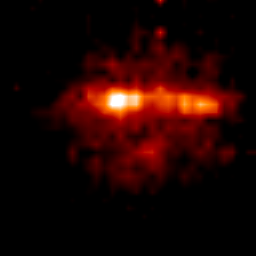 |
|
Animated sequence of Jupiter |
At 5 microns, ISO sees deep into the atmosphere, in the belts between the cloud zones. The bright spots conspicuous north of the equator are hot dry regions, similar to the one visited by the Galileo probe.
Around 7.7 microns, ISO is looking at the upper atmosphere (stratosphere) of Jupiter. The south polar region glows bright. In the last images, Jupiter is becoming too hot for the camera The rate of frequency change is not constant. Thus 3 microns is attained at frames 15-16, 4 microns at 31-32, 5 microns at 44-47, 6 microns at 54-55, 7 microns at 63-64, 8 microns at 69-70, 9 microns at 74-75, 10 microns at 82-83, and 11 microns at 87-88.
ISOCAM operated with an image scale of 1.5 seconds of arc per pixel in the circular variable filter mode. The equator of Jupiter spans about 30 pixels.

